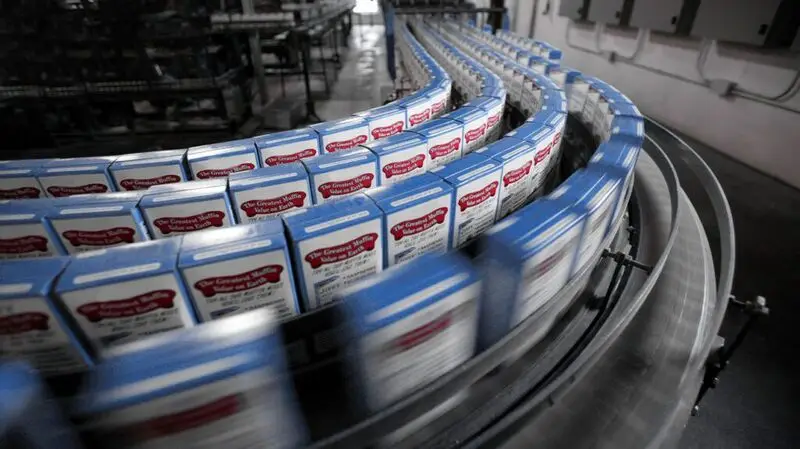
- Diets high in ultra-processed foods corresponded to a strong presence of intramuscular thigh fat deposits in a new study.
- Such fat deposits have been linked to a weakening of muscles that are important for protecting cartilage that supports knee joint health.
- Correcting one’s diet can reduce fat deposits to help restore healthy muscle, repair cartilage, and slow or halt further joint damage.
People who consumed diets high in ultra-processed foods had increased fat deposits in their thighs, according to a new study, increasing their risk of knee osteoarthritis.
The intramuscular fat deposits were found to occur regardless of the number of calories the participants in the study consumed or their level of physical activity.
The results of the imaging study were presented at the Annual Meeting of the Radiological Society (RSNA) of North America in Chicago, in December 2024. It is yet to appear in a peer-reviewed journal.
Previous research has found that the replacement of muscle in the thigh with fat is associated with reduced knee function. This is the first study that clearly ties this phenomenon to the consumption of ultra-processed foods.
Ultraprocessed foods are industrially produced foods that are a staple of many diets, although they have been linked to various medical issues. These foods are primarily formulated for flavor, convenience and low cost, with nutritive value less of a priority.
They typically contain five or more ingredients, and are high in sugar and fats. Ultra-processed foods are likely to contain additives, such as flavor enhancers, food colorings, sweeteners, and preservatives, as well as modified starches and hydrogenated fats.
In the new study, researchers analyzed MRI imaging from 666 individuals who participated in a nationwide study, the
Study author Zehra Akkaya, MD, a radiologist at Ankara University in Turkey, noted in a press release that, “on MRI images, this decline can be seen as fatty degeneration of the muscle, where streaks of fat replace muscle fibers.”
“We assumed that ultraprocessed foods increase insulin resistance and adipose tissue — visceral fat — which is dangerous fat and [is linked to] inflammation and diabetes,” Gowri Reddy Rocco, MD, MS, founder and president of Optimum Wellness And Longevity, who was not involved in the study, told Medical News Today.
Rocco said of its findings that “this is something that’s tangible,“ and “to show that [ultra-processed foods] replace the muscle with fat, that’s pretty novel.“
Paul Arciero, MS, DPE, professor in the Health and Human Physiological Sciences Department at Skidmore College in Saratoga Springs, NY, likewise not involved in the study, hypothesized that:
“The most likely trigger of [an ultra-processed food] diet that leads to increased total body, and specifically thigh, fat is the highly processed sugar intake from grains, high fructose corn syrup, soda, candy, cookies, juices, and other packaged foods.”
“Other contributing sources are sodium from processed animal products and excess refined fats and oils — hydrogenated, fried foods, margarine, trans fats, and chips — in these foods. All of these processed foods trigger the release a pro-inflammatory substances such as glucose, insulin, cytokines, and other damaging molecules such as free radicals. These substances also increase pain,” Arciero explained to MNT.
“Osteoarthritis is the most common form of arthritis,” said Rocco. “It’s chronic inflammation in one or more of the joints. Inflammation starts deteriorating the cartilage there, which is a spongy material, if you will, that helps keep the joint healthy.”
“When you exercise, your muscles strengthen your joints. Muscle weakness is actually a risk factor for osteoarthritis,” she noted.
However, Rocco pointed out, when “muscle fiber in the thigh is getting replaced with fat fibers, your muscles are much weaker and regardless of your exercise, regardless of your calorie intake,” they can no longer be as effective at keeping the joints healthy, allowing osteoarthritis to develop and progress.
Fortunately, when one’s diet is corrected, muscle can regenerate, become stronger, and regain the ability to strengthen cartilage and protect joints. Joint damage cannot be repaired, but it may be slowed or halted.
“A poor diet of [ultra-processed foods], inactivity, sitting, overweight and obesity are the primary risk factors” for knee osteoarthritis, said Arciero. “There may be a small genetic component, however lifestyle is by far the greatest risk factor.”
“Obesity,” Rocco opined, “is probably the most common now because, sadly, we’re seeing osteoarthritis starting in younger age groups, 30s and 40s, as opposed to before, when it used to be more at 45 and older.”
“Obesity increases stress and strain on the knees, on the hips, on the body. So number one is to lose weight to reduce overuse of joints,” she added.
“Excessive wear and tear through repetitive movement patterns,” noted Arciero, “improper footwear and biomechanics may also play a role.”
“Menopause is a risk factor as well, for women,” Rocco.
If you are concerned about being at risk for knee osteoarthritis, there are ways to diagnose the presence of intramuscular thigh fat.
“An experienced clinician, trainer, exercise physiologist, or healthcare professional may obtain indirect measures of fat accumulation in the thigh,” said Arciero.
“This may be done,” he noted, using “circumference measures, skinfolds, and bioelectrical impedance analysis (BIA) measurements that are relatively easy to perform in any outpatient, fitness, healthcare setting.”
“Beyond that, an iDXA (dual X-ray absorptiometry) scans can also quantify the amount of fat present in the thigh. However, these are more specialized and costly and only available in healthcare or research settings,” Arciero added.
A preventive approach remains the best bet.
“Healthy eating is the most effective lifestyle strategy to combat excess fat accumulation located anywhere in the body, especially abdominal (visceral) fat, hips, and thighs,” suggested Arciero.
“Our lab has been demonstrating the efficacy of this nutrition strategy to drastically reduce thigh, hip, and belly fat for several decades,” he reported.





